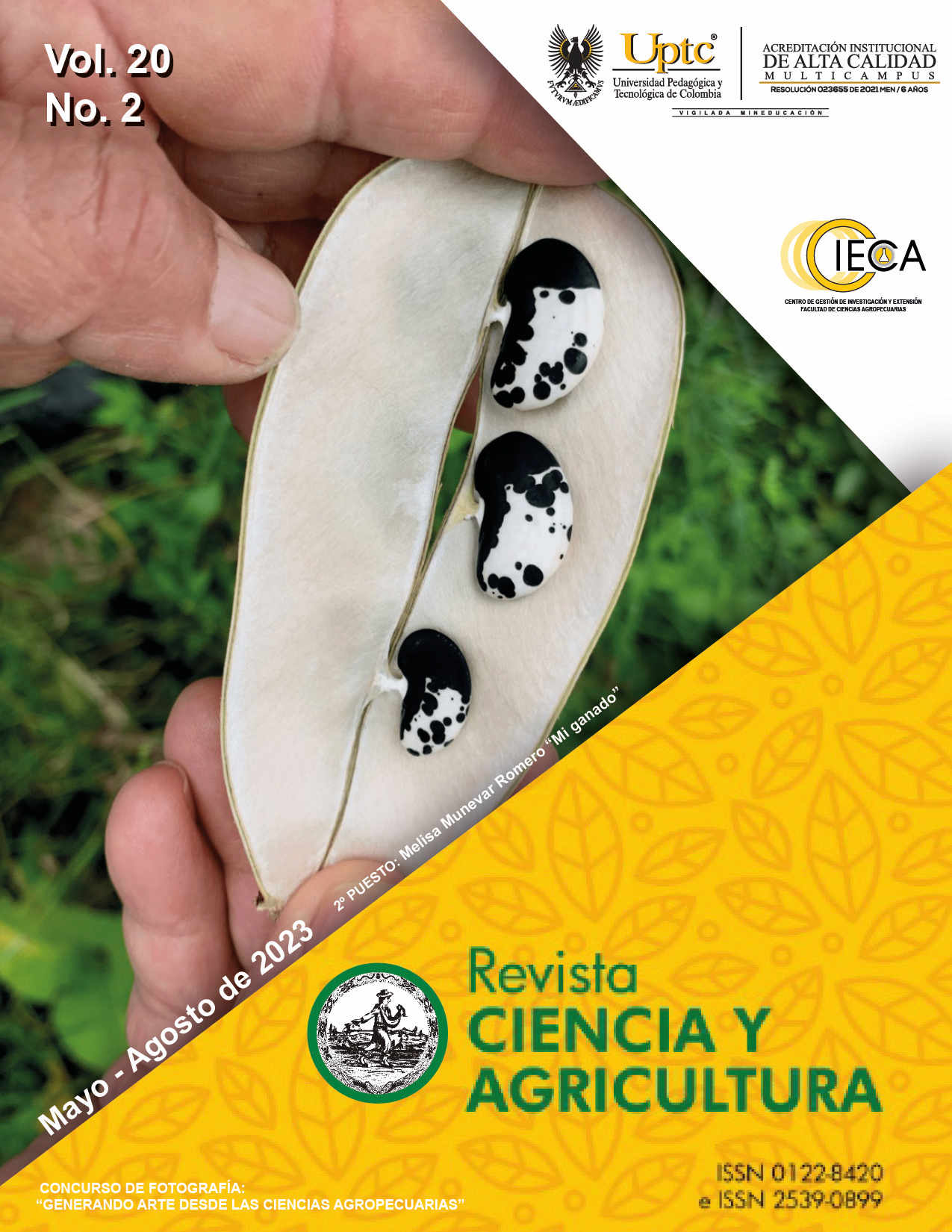Determinants for Disease Management in Cacao (Theobroma cacao L.) in Southern Córdoba, Colombia

Abstract
The southern region of Córdoba has included the cultivation of cocoa within the offer of agricultural products for about two decades, motivated by the action of public and private entities in the agricultural sector. Although their yields are very close to the national average, they have decreased in the last two years due to diseases. This work aims to identify the factors that influence the decision to use disease management technologies. A survey was applied to 158 producers selected by the simple random sampling method. For the analysis, descriptive statistics and the formulation of a McFadden-type logit econometric model of discrete choice were used. The results show that the producer identifies to monilia (Moniliophthora roreri), witch's broom (Moniliophthora perniciosa) and Phytophthora (Phytophthora sp.) as the main diseases. The most used techniques are cultural management practices such as the manual harvesting of affected fruits and, in some cases, the use of chemically synthesized fungicides. It is concluded that the technological level and the participation in projects are the factors that have positively influenced the decision to use disease management techniques; schooling and years as a farmer slow down the willingness to apply disease management techniques.
Keywords
Adoption, Pest control, Yields, Profitability
References
- Acevedo-Osorio, A., Santoyo-Sánchez, J. S., Guzmán, P. & Jiménez-Reinales, N. (2018). La Agricultura Familiar frente al modelo extractivista de desarrollo rural en Colombia. Gestión y Ambiente, 21(Supl. 2), 144–154. https://doi.org/10.15446/ga.v21n2supl.73925 DOI: https://doi.org/10.15446/ga.v21n2supl.73925
- Acuña, K. (2007). Tsuru: el cacao en Alta Talamanca. Revista Herencia, 20(1–2), 83–98.
- Agronet, Red de Información y Comunicación del Sector Agropecuario Colombiano (2023, mayo). Reporte: área, producción y rendimiento nacional por cultivo (base de datos). https://www.agronet.gov.co/estadistica/Paginas/home.aspx?cod=1
- Antolinez, E. Y., Almanza , P. J., Barona, A. F., Polanco, E., & Serrano, P. A. (2020). Estado actual de la cacaocultura: una revisión de sus principales limitantes. Ciencia y Agricultura, 17(2), 1–11. https://doi.org/10.19053/01228420.v17.n2.2020.10729 DOI: https://doi.org/10.19053/01228420.v17.n2.2020.10729
- Cely, L. A. (2017) Oferta productiva de cacao colombiano en el posconflicto. Estrategias para el aprovechamiento de oportunidades comerciales en el marco del acuerdo comercial Colombia-Unión Europea. Equidad y Desarrollo, (28), 167-195. https://doi.org/10.19052/ed.4211 DOI: https://doi.org/10.19052/ed.4211
- Cuevas-Reyes, V., Sánchez, B. I., Servín, R., Reyes, J. E., Loaiza, A., & Moreno, T. (2020). Factores determinantes del uso de sorgo para alimentación de ganado bovino en el noroeste de México. Revista Mexicana de Ciencias Pecuarias, 11(4), 1113–1125. https://doi.org/10.22319/rmcp.v11i4.5292 DOI: https://doi.org/10.22319/rmcp.v11i4.5292
- Darkwah, S. A., & Verter, N. (2014). An empirical analysis of cocoa bean production in Ghana. European Scientific Journal, 10(16), 295–306.
- FEDECACAO, Federación Nacional de Cacaoteros de Colombia (2022). Caracterización de productores de cacao 2017-2021 (data base). https://www.fedecacao.com.co/documentos-tecnicos
- Flórez, A., Muñoz, C., Sáenz, B., Rodríguez, N., Siachoque, R., Otero, J., Páramo, G., Martínez, O., Bonilla, G. Rangel, E., Soriano, O. Ríos, H., Garcés, E., Porras, A., Gaitán, H., Rangel, S., Morales, M., Ortiz, L., & Roldán, J. (2018). Cultivo comercial de cacao: identificación de zonas aptas en Colombia, a escala 1: 100.000. UPRA.
- Gujarati, D. N., & Porter, D. C. (2004). Econometría (5a ed). McGraw-Hill.
- McFadden, D. (1973). Conditional logit analysis of qualitative choice behavior. In P. Zarembka (Ed.) Frontiers in econometrics (pp. 105–142). Academic Press.
- McFadden, D. (2000). Economic choices. Prize Lecture. https://www.nobelprize.org/prizes/economic-sciences/2000/mcfadden/lecture/
- Maddala, G. S., (1996). Introducción a la econometría. John Wiley & Sons.
- Manly, B. F. J., McDonald, L. L., Thomas, D. L., McDonald, T. L., & Erickson, W. P. (2002). Resource selection by animals: statistical design and analysis for field studies (2a ed.). Springer Dordrecht. https://doi.org/10.1007/0-306-48151-0 DOI: https://doi.org/10.1007/0-306-48151-0
- Martínez, A., Avendaño, B., & Acosta, A. (2011). Determinantes de la adopción de estándares en el subsector hortícola del Noroeste de México. Ciencia y Tecnología Agropecuaria, 12(2), 175–181. https://doi.org/10.21930/rcta.vol12_num2_art:229 DOI: https://doi.org/10.21930/rcta.vol12_num2_art:229
- Martínez, A. M., Grandett, L. M., Novoa, R. S., Martínez, J. C., Contreras, J. L., & Berrio, E. E. (2022). Análisis técnico-económico del sistema de producción de Theobroma cacao L. en el departamento de Sucre, Colombia. Revista de Investigación e Innovación Agropecuaria y de Recursos Naturales, 9(3), 46–55. https://doi.org/10.53287/isbx9599ib60m DOI: https://doi.org/10.53287/isbx9599ib60m
- Ojonimi, A., Janet, N. & Ifeyinwa, A. (2012). Profitability and yield determinants in Nigerian cocoa farms: evidence from Ondo State. Journal of Sustainable Development in Africa, 14(4), 172–182.
- Pindyck, R. S., & Rubinfeld, D. L. (2001). Econometría: modelos y pronósticos. McGraw Hill.
- Ramírez, J. C., Valero, G. M. & Martínez, P. (2019). Oportunidades de las minicadenas productivas del sector cacao de santander frente al pos conflicto colombiano. Económicas CUC, 40(2), 153–182. https://doi.org/10.17981/econcuc.40.2.2019.10 DOI: https://doi.org/10.17981/econcuc.40.2.2019.10
- Rodríguez, J. (2001). Métodos de muestreo. Cuadernos Metodológicos 1. Centro de Investigaciones Sociológicas; Siglo XXI de España Editores.
- Sarkodie, E. E., Yusif, H. M., & Boachie, W. K. (2017). Determinants of cocoa production in the Ashanti region. Direct Research Journal of Agriculture and Food Science, 5(1), 21–25.
- Sierra, D. C. (2016). El cacao como producto líder en la sustitución de cultivos ilícitos en el proceso de posconflicto [Tesis de grado, Universidad Militar Nueva Granada]. https://repository.unimilitar.edu.co/handle/10654/15777
- Traxler, G. & Byerlee, D. (1993). La investigación y la extensión sobre el manejo de cultivos: los productos y sus efectos en la productividad. Monografías en Economía del CIMMYT 5.
